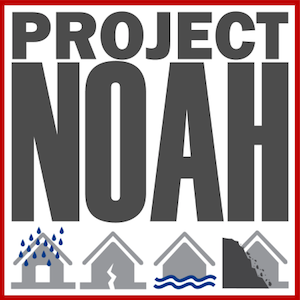As of November this year, Philippine has been hit by 22 storms, with 4 more expected to come before the year ends.
While heavy rains and landslides are natural disasters which often cannot be predicted with accuracy, the government has been trying hard to increase the country’s prepareness for disaster. Looks like they will do it with style.
Enter Project NOAH, short for Nationwide Operational Assessment of Hazards. A project of the Philippines’ Department of Science and Technology, it started as response on the call to establish a program that can provide data to the government and warn agencies 6 hours in advance in any possible cases of impending landslides and flashfloods. It was also specified that the project must use technology to provide the data.
An important part of Project NOAH focuses on flooding. One of its original goals is to map all flood-prone areas in the Philippines. This way, simulation through the computer can be done to know the water level of an incoming flood, based on the data on the typhoon. Citizens and local government officials alike do not have to wait for the final hour to evacuate people.
So far, flood models have been mapped on cities including Davao, Marikina, and Davao Oriental. Marikina is a known flood-prone area. The city was heavily devastated by the typhoon Ondoy (International name: Ketsana), which hit the country in 2009. It is expected that all the flood models will be completed by June 2014. A number of universities are expected to help in finishing the flood models.
To disseminate information down to the baranggay level, the project has also created a special tablet which is specifically used for receiving information related to weather and flood. However, Project Noah’s goals extend beyond tablets and flood models. Its most ambitious objective is to map all the hazard areas in the Philippines using 3D modelling, as well as satellite feed of typhoons that come to country, to be broadcasted live on TV and the Internet.
All of these are expected to be completed and functional by 2016.
The project’s biggest contribution so far is its interactive website at noah.dost.gov.ph which allows visitors to know exactly the weather condition in any specific location in the country. In the search bar, type in a city and a type of overview (ex. 12-hour or 24-hour rainfall overview) and the website can immediately inform the user on the weather forecast for that particular location.
Right now, the website’s broad and vast array of data is of much more use to local government officials in planning ahead in case an impending storm or typhoon will hit the country. The government, in case you don’t know, is also using social media to disseminate information to the public. For Twitter users, here is a short list of government agencies and officials to follow:
Benigno Aquino III is the current President of the Republic of the Philippines. Should there be a natural calamity happening in the country, this Twitter handle will disseminate information about it.
[Adm-02] Emergency Hotlines for #Undas2013 pic.twitter.com/Z3GitOKXAU
— Noynoy Aquino (@noynoyaquino) November 1, 2013
Philippine Atmospheric, Geophysical and Astronomical Services Administration, more commonly known as PAGASA, is the country’s weatherman. It will tweet virtually everything related to storms and typhoons to even the slightest drop of rain in any specific location in the country.
THUNDERSTORM ADVISORY No.10 #VPRSD 10:20PM (03NOV'13) Expect thunderstorm over #NegrosOccidental (Cadiz City,… http://t.co/icsp3lgNv9
— PAGASA-DOST (@dost_pagasa) November 3, 2013
DepED or the Department of Education is the agency concerned with the welfare of all the students in the country. While it is not always in their capability to announce suspension of classes during thunderstorms, it is wise to follow this Twitter handle in case classes are suspended.
Magandang araw po! For any questions, concerns, or complaints, contact us: action@deped.gov.ph | 02 636 1163, 02 633 1942 | 63 919 456 0027
— DepEd (@DepEd_PH) October 30, 2013
For the latest on the state of traffic in Metro Manila, the MMDA’s Twitter handle might come in handy.
TRAFFIC UPDATE: As of 6:45 PM, C5 SB; C.P Garcia to Xavierville-(MH) Libis to B.Ilog-(MH) Kalayaan-(L). #mmda
— Official MMDA (@MMDA) November 4, 2013
What do you think of Project Noah? Do you think it can help in the government’s efforts in preparing the country against natural calamities?
Read also: You Will Never Get Lost In Manila With These Apps
